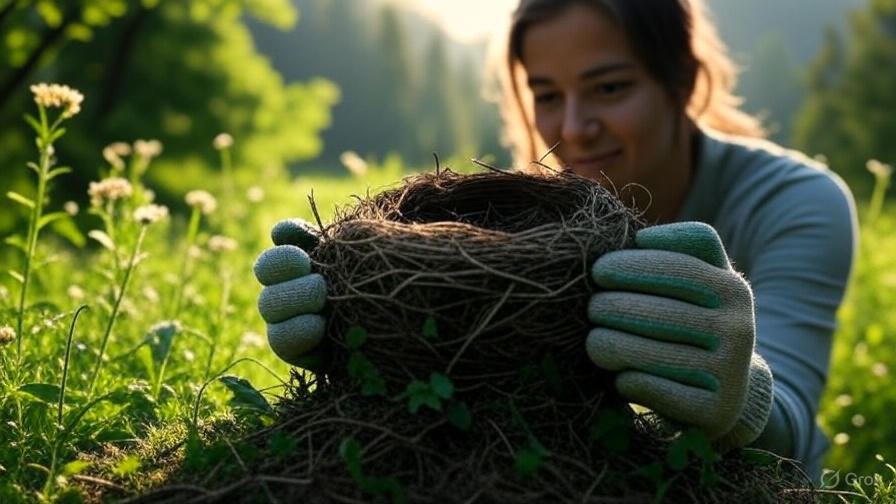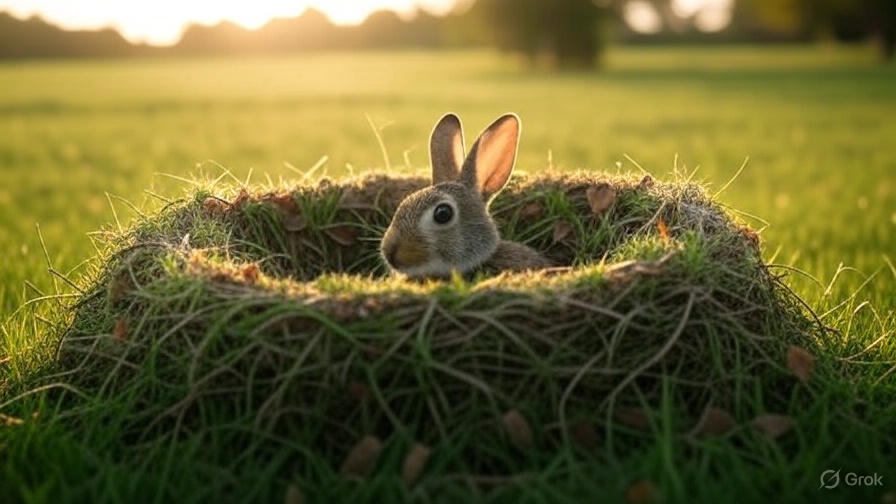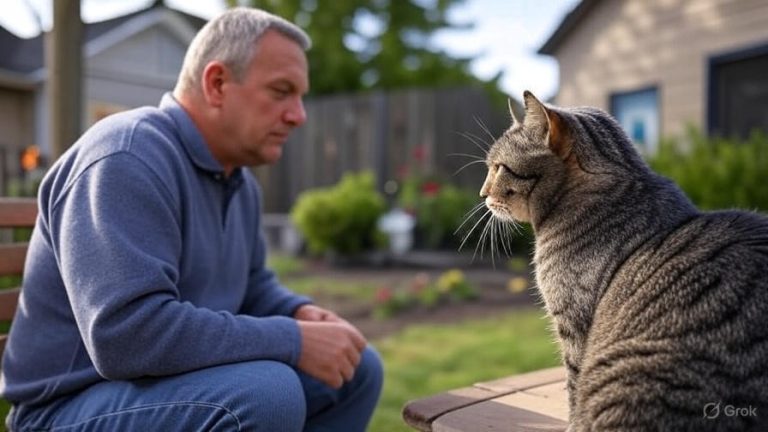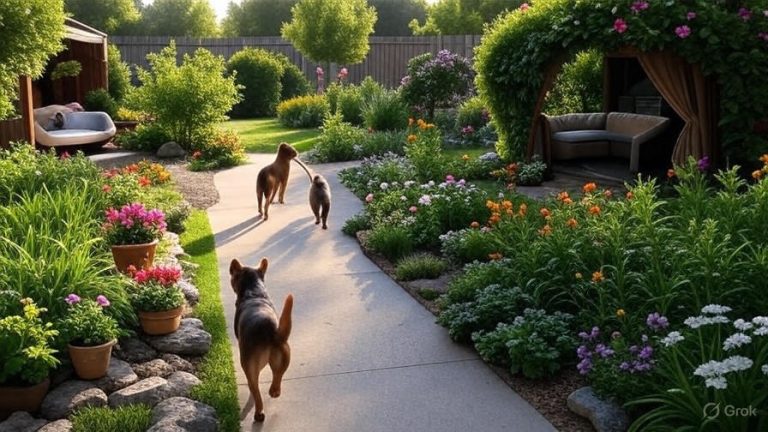How to Find a Rabbit Nest?
Spring brings many surprises to your backyard, and discovering a rabbit nest ranks among the most delightful. Wild rabbits create their homes in unexpected places, often right under our noses. Learning how to spot these hidden nurseries helps you protect baby rabbits while maintaining your garden.
Why Rabbits Build Nests in Your Yard
Wild rabbits seek specific conditions when building their nests. They need safety from predators, protection from weather, and easy access to food sources. Your yard likely provides all three requirements.
Cottontail rabbits prefer areas with short grass surrounded by taller vegetation. This combination gives them clear sightlines for spotting danger while offering quick escape routes. Gardens, lawns, and flower beds create perfect rabbit habitat.
Female rabbits, called does, start nest-building activities in early spring. They continue creating new nests throughout the breeding season, which extends from March through September in most regions. Each doe produces multiple litters per year, making nest discovery more likely during warmer months.
Common Rabbit Nest Locations
Rabbits construct their nests in surprisingly diverse locations. Open lawn areas rank among the most frequent nesting spots. Does dig shallow depressions directly in grass, creating what experts call “forms.” These simple structures blend seamlessly with surrounding turf.
Flower beds attract nesting rabbits because loose soil makes digging easier. The protective cover of plants shields young rabbits from aerial predators like hawks and owls. Mulched areas provide extra insulation for growing babies.
Shrub borders offer excellent nesting opportunities. Rabbits tunnel under bushes, creating protected spaces between root systems and ground level. Dense vegetation conceals nest entrances while providing multiple escape routes.
Garden edges serve as prime real estate for rabbit families. The transition zone between cultivated and wild areas gives rabbits access to both food sources and shelter. Compost piles, brush heaps, and stored materials create additional nesting opportunities.
Rabbits also utilize man-made structures for nest sites. Spaces under decks, sheds, and porches provide weather protection. Gaps in retaining walls, drain pipes, and storage areas become temporary homes for growing rabbit families.
Physical Signs of Rabbit Nests
Recognizing the visual clues helps you locate rabbit nests before accidentally disturbing them. Fresh digging marks appear as small, circular depressions in soil or grass. These excavations measure roughly four to five inches across and two to three inches deep.
Rabbit fur serves as a telltale indicator of nearby nests. Does pluck soft belly fur to line their nest cavities. This gray-brown material creates insulation for newborn rabbits. You might find tufts of fur caught on nearby plants or scattered around digging sites.
Disturbed vegetation provides another important clue. Rabbits clear away grass, leaves, and debris while preparing nest sites. They often arrange this material to camouflage nest entrances. Look for patches where ground cover appears flattened or rearranged.
Rabbit droppings increase dramatically near active nests. These small, round pellets scatter throughout the area as parent rabbits travel back and forth. Fresh droppings appear dark and moist, while older ones turn light brown and crumbly.
Plant damage indicates rabbit presence in your yard. Nibbled grass stems, chewed flower heads, and stripped bark show where rabbits feed. Heavy browsing near potential nest sites suggests active rabbit families.
Behavioral Clues from Adult Rabbits
Adult rabbit behavior reveals nest locations through careful observation. Does follow established travel routes between feeding areas and nest sites. These paths appear as compressed grass or bare soil strips leading through your landscape.
Early morning and evening hours provide the best opportunities for rabbit watching. Does visit nests primarily during dawn and dusk periods to avoid daytime predators. Patient observers can track these movements to discover nest locations.
Alarm behaviors signal nearby rabbit nests. Adult rabbits thump their hind feet when sensing danger near their young. This drumming sound carries surprisingly long distances. Frequent thumping in specific yard areas suggests nest proximity.
Distraction displays help parent rabbits protect their offspring. Does deliberately expose themselves to draw predators away from hidden nests. If you notice rabbits acting unusually bold or conspicuous, their nest likely sits nearby.
Territorial disputes between rabbits indicate established nesting areas. Males chase competing rabbits away from territories containing active nests. Repeated conflicts in the same location suggest important rabbit real estate.
Seasonal Timing for Nest Discovery
Rabbit nesting follows predictable seasonal patterns that affect discovery success. Early spring marks the beginning of primary nesting season. Does prepare their first nests when temperatures consistently reach above freezing.
Late spring through early summer represents peak nesting activity. Most rabbit litters arrive during this period when food sources reach maximum abundance. Your chances of finding active nests increase dramatically from April through June.
Mid-summer brings continued nesting but with reduced intensity. Hot weather stress limits breeding activity in many rabbit populations. However, suburban rabbits with access to water and shade often continue producing litters throughout summer months.
Early fall sees a final surge in rabbit nesting behavior. Cooler temperatures trigger renewed breeding activity as rabbits prepare for winter. These late-season nests often contain fewer babies than spring litters.
Winter nesting occurs rarely in most climates. Extreme cold, limited food, and harsh weather make successful reproduction unlikely. Only southern regions with mild winters support year-round rabbit breeding.
What Rabbit Nests Look Like
Rabbit nest appearance varies significantly based on location and materials available. Ground nests in open areas consist of shallow scrapes lined with grass, leaves, and rabbit fur. The depression barely reaches below ground level.
Nest coverings provide crucial camouflage and protection. Does arrange grass, twigs, and debris over nest openings. This material looks random but forms an effective barrier against predators and weather. Light pressure easily moves these coverings aside.
Interior nest construction focuses on warmth and comfort. Soft rabbit fur creates a cozy lining for helpless baby rabbits. Does add dried grass, moss, and other insulating materials as available. The finished nest resembles a small, fur-lined cup.
Nest size remains surprisingly compact despite housing multiple babies. Most rabbit nests measure only six to eight inches across at the surface. The interior cavity spans about four inches in diameter and three inches deep.
Multiple nest chambers sometimes connect in complex sites. Does occasionally dig tunnels linking several nest cavities. This design provides escape routes and extra space for growing litters.
Baby Rabbit Development Stages
Baby rabbit growth affects nest activity and discovery timing. Newborn rabbits, called kits, arrive blind, deaf, and nearly hairless. They remain completely dependent on their mother for warmth and nutrition during the first week.
Eyes open around ten days after birth, marking a crucial development milestone. Kits become more active within the nest cavity but still require constant maternal care. This period offers the best opportunities for observing nest activity.
Fur development begins during the second week of life. Young rabbits grow their first coat of soft, gray-brown fur. They start moving around the nest more frequently and may venture to the entrance on warm days.
Weaning begins around three weeks of age when kits start eating solid food. They make brief excursions from the nest to sample nearby vegetation. These short trips gradually increase in duration and distance.
Independence arrives at four to five weeks of age. Young rabbits permanently leave their birth nest to establish individual territories. Empty nests may be reused by does for subsequent litters.

Safety Considerations When Searching
Approaching rabbit nests requires extreme caution to avoid harm or abandonment. Does possess acute hearing and will detect human presence from considerable distances. Loud noises or sudden movements can trigger permanent nest abandonment.
Minimal disturbance proves essential for nest survival. If you discover an active rabbit nest, observe from at least ten feet away. Never handle baby rabbits unless they appear injured or genuinely orphaned.
Scent contamination poses serious risks to nest success. Human odors on baby rabbits or nest materials may cause mothers to reject their young. Always wear gloves if you must handle nest components for safety reasons.
Pet control becomes critical during nesting season. Dogs and cats pose extreme threats to rabbit families. Keep pets leashed or confined when rabbit nests exist in your yard. Even well-behaved pets can accidentally disturb hidden nests.
Timing your search activities reduces stress on rabbit families. Avoid nest areas during peak activity periods around dawn and dusk. Mid-day searches cause less disruption to normal rabbit routines.
Tools for Rabbit Nest Detection
Simple equipment improves your nest-finding success without harming rabbit families. Binoculars allow close observation from safe distances. Choose models with good close-focus capabilities for backyard wildlife watching.
Flashlights help illuminate potential nest sites under decks, sheds, and dense vegetation. Use red-filtered lights to minimize disturbance to rabbit vision. Many animals perceive red light less readily than white illumination.
Garden mirrors mounted on extendable handles let you check hidden spaces without physical intrusion. Mechanics’ mirrors work perfectly for peering under structures and into tight spaces.
Trail cameras provide excellent nest monitoring tools for patient observers. Position cameras at least five feet from suspected nest sites. Review footage during daylight hours to minimize disturbance.
Smartphone apps help identify rabbit tracks, droppings, and other sign. Several wildlife identification programs include detailed information about rabbit behavior and habitat preferences.
Protecting Discovered Nests
Once you locate a rabbit nest, protection becomes your primary responsibility. Mark the area with bright flags or stakes placed at least three feet from the nest entrance. This prevents accidental disturbance during lawn care or gardening activities.
Modify your yard maintenance schedule around active nests. Postpone mowing, weed trimming, and other disruptive activities until young rabbits leave the area. Most nests remain active for only four to five weeks.
Create buffer zones around nest sites to reduce stress on rabbit families. Avoid walking, playing, or working within ten feet of known nests. Route foot traffic and activities around these sensitive areas.
Educate family members and visitors about nest locations and protection needs. Children especially need guidance about maintaining safe distances from wild animal homes. Post temporary signs if necessary to remind others about nest locations.
Monitor nest activity from a distance to ensure continued use. Daily observations from your house or deck help track rabbit family progress. Note feeding visits by adult does and eventual departure of young rabbits.
What to Do If You Find Baby Rabbits
Discovering baby rabbits outside their nest creates confusion for many homeowners. Young rabbits often appear abandoned when they are actually receiving normal maternal care. Does visit nests only twice daily to avoid attracting predators.
Observe for at least 24 hours before assuming abandonment. Mark the area and check for signs of adult rabbit activity. Fresh droppings, disturbed nest coverings, and rearranged fur indicate ongoing maternal care.
Contact wildlife rehabilitation centers if babies appear genuinely orphaned or injured. Professional rehabbers possess the skills and permits necessary for raising wild rabbits. Attempting home care usually results in kit mortality.
Avoid moving apparently healthy baby rabbits found outside nests. Young rabbits begin exploring around three weeks of age. They may spend increasing time away from nest sites while still returning for nursing.
Document your observations with photos and notes. This information helps wildlife experts determine appropriate intervention strategies. Include details about baby rabbit size, behavior, and nest condition.
Common Mistakes to Avoid
Many well-intentioned people make errors that harm rabbit families. Handling baby rabbits ranks among the most damaging mistakes. Human scent on kits may cause mothers to abandon their young permanently.
Removing nest coverings creates exposure problems for developing rabbits. These materials provide essential temperature regulation and predator protection. Resist the urge to peek at babies by uncovering nests.
Providing food or water near nests actually increases danger to rabbit families. Artificial feeding attracts predators and may interfere with natural weaning processes. Adult rabbits will find adequate resources independently.
Moving discovered nests to “safer” locations almost always results in abandonment. Does remember exact nest locations and will not search for relocated young. Even short-distance moves prove fatal to rabbit families.
Assuming nest abandonment too quickly leads to unnecessary interference. Many people mistake normal rabbit behavior for neglect. Does naturally spend most of their time away from nests to avoid attracting predators.
Long-term Rabbit Management
Creating rabbit-friendly landscapes while protecting your garden requires careful planning. Native plant selections provide natural food sources that reduce crop damage. Native grasses, wildflowers, and shrubs support rabbit populations sustainably.
Habitat modification offers humane population control methods. Removing brush piles, trimming dense vegetation, and eliminating water sources reduces carrying capacity for rabbit populations.
Exclusion techniques protect valuable plants without harming rabbits. Fencing, plant cages, and row covers prevent damage while allowing rabbits to remain in the area. Choose materials that provide long-term protection.
Natural predator encouragement helps maintain ecological balance. Owl boxes, hawk perches, and native plantings support natural rabbit control. Avoid pesticides and rodenticides that harm beneficial predators.
Seasonal yard management reduces human-rabbit conflicts. Time major landscaping projects for late fall or early spring when nest activity remains minimal. Plan garden installations around peak breeding seasons.
Conclusion
Finding rabbit nests in your yard connects you with the amazing wildlife sharing your space. These discoveries offer opportunities to observe natural behaviors while teaching valuable conservation lessons. Remember that wild rabbits make excellent neighbors when we respect their needs and provide appropriate habitat.
Your careful observation skills and protective actions ensure successful rabbit reproduction in urban and suburban environments. Each nest you help protect contributes to maintaining healthy rabbit populations for future generations to enjoy. The patience required for finding and protecting rabbit nests rewards you with unique insights into the natural world right outside your door.







